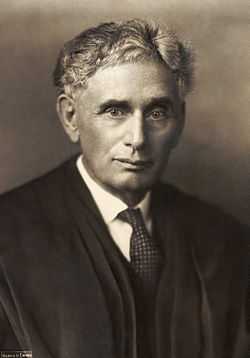Fairchild v. Hughes
| Fairchild v. Hughes | |||||||
|---|---|---|---|---|---|---|---|
|
| |||||||
| Argued January 23 – January 24, 1922 Decided February 27, 1922 | |||||||
| Full case name | Oscar Leser, et al. v. Garnett et al. | ||||||
| Citations | |||||||
| Court membership | |||||||
| |||||||
| Case opinions | |||||||
| Majority | Brandeis, joined by unanimous | ||||||
| Laws applied | |||||||
| Case or Controversy Clause, U.S. Const. Art. III | |||||||
Fairchild v. Hughes, 258 U.S. 126 (1922),[1] was a case in which the Supreme Court of the United States held that a general citizen, in a state that already had women's suffrage, lacked standing to challenge the validity of the ratification of the Nineteenth Amendment. A companion case, Leser v. Garnett upheld the ratification.[2][3][4]
Background
In 1919, the United States Congress proposed a Constitutional amendment reading: "Section 1: The right of citizens of the United States to vote shall not be denied or abridged by the United States or by any State on account of sex." "Section 2: Congress shall have power to enforce this article by appropriate legislation." By July 1920, thirty-five states had ratified the proposal, with only one additional state needed for the Amendment to be adopted.

On July 7, 1920, Charles S. Fairchild challenged the validity of the ratification process for that Amendment in the Supreme Court of the District of Columbia. The challenge sought to prevent Secretary of State Charles Evans Hughes from officially declaring the Amendment valid. The district court dismissed the case on July 20, and Fairchild appealed to the Court of Appeals of the District of Columbia. On August 26, Hughes acknowledged Tennessee's ratification, and the Nineteenth Amendment to the United States Constitution became law. The Court of Appeals affirmed the lower court decision. The case was appealed to the Supreme Court.[3][5] In November 1921, the Supreme Court agreed to hear the case, which was argued in January 1922.[6]
Opinion of the Court

In February, the Court announced a unanimous decision authored by Associate Justice Louis Brandeis, concluding that Fairchild, as a private citizen, lacked standing to challenge the amendment's ratification under the limitations of the Case or Controversy Clause of Article III.[1][6] On the same day, the Court also decided a companion case, Leser v. Garnett which upheld the Amendment's ratification process on the merits.
The Fairchild decision marked a departure from prior doctrine, which had allowed any citizen to sue to preserve a public right.[7]
Subsequent developments
This case is often seen as one of two cases, along with Frothingham v. Mellon, that became the genesis of the doctrine of legal standing. However, the term standing was not associated with Article III until the New Deal era.[8][9]
See also
References
- ↑ 1.0 1.1 258 U.S. 126 Full text of the opinion courtesy of Findlaw.com.
- ↑ Vile, John R. (2003-05-01). Encyclopedia of Constitutional Amendments, Proposed Amendments, and Amending Issues: 1789-2002. ABC-CLIO. pp. 184–. ISBN 9781851094288. Retrieved 13 December 2012.
- ↑ 3.0 3.1 Bradeis, Louis D. (1978-06-30). Letters of Louis D. Brandeis: 1921-1941, Elder statesman: 1921-1941. SUNY Press. pp. 47–. ISBN 9780873953306. Retrieved 13 December 2012.
- ↑ Renstrom, Peter G. (2003). The Taft Court: Justices, Rulings, and Legacy. ABC-CLIO. pp. 111–. ISBN 9781576072806. Retrieved 13 December 2012.
- ↑ McGovney, Dudley Odell; Howard, Pendleton (1955). Cases on constitutional law. Bobbs-Merrill. p. 71. Retrieved 13 December 2012.
- ↑ 6.0 6.1 Wroth, Lawrence Counselman (1921). The Johns Hopkins Alumni Magazine: Published in the Interest of the University and the Alumni. The Johns Hopkins Alumni Association. p. 20. Retrieved 13 December 2012.
- ↑ The Metaphor of Standing and the Problem of Self-Governance, by Steven L. Winter, 40 Stan. L. Rev. 1371, July, 1988.
- ↑ Stearns, Maxwell L. (2002-05-01). Constitutional Process: A Social Choice Analysis of Supreme Court Decision Making. University of Michigan Press. pp. 385–. ISBN 9780472088683. Retrieved 13 December 2012.
- ↑ "Who May Test the Constitutionality of a Statute in the Supreme Court". Harvard Law Review 47 (4): 678. Feb 1934. doi:10.2307/1331986.
